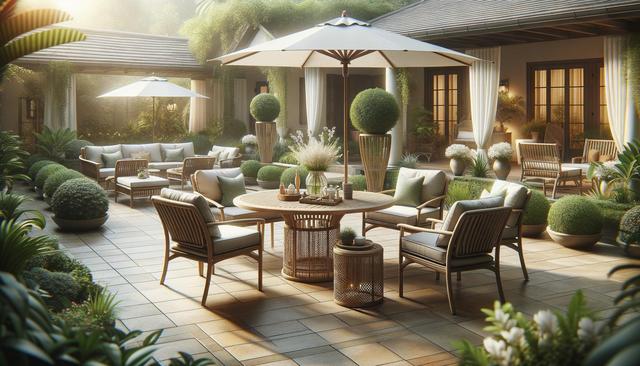Creating a Comfortable Outdoor Living Space with Patio Furniture
Patio furniture can transform any outdoor area into a functional and inviting extension of your home.

Choosing the Right Patio Furniture for Your Space
Before purchasing patio furniture, it’s essential to assess the space you have and how you plan to use it. Whether you have a spacious backyard, a small balcony, or a cozy porch, the right furniture can enhance usability and comfort. Consider the dimensions of your area to ensure the furniture fits well without overcrowding. Think about your lifestyle too—do you entertain often, or are you looking for a quiet place to relax? These factors will influence your selection.
Additionally, take note of the layout and architectural style of your home. Your outdoor furniture should complement your existing design. For example, clean lines and neutral tones may suit a modern aesthetic, while wooden or wrought iron pieces might align better with traditional or rustic settings. Planning ahead ensures a cohesive and balanced look that feels like a natural extension of your indoor living spaces.
Materials That Withstand the Elements
Outdoor furniture is exposed to various weather conditions, so material choice is crucial. Some materials are better suited for durability and minimal maintenance than others. Here are a few common options:
- Teak: Known for its weather-resistant properties and long-lasting quality.
- Aluminum: Lightweight and rust-resistant, ideal for humid or coastal areas.
- Wicker (synthetic): Offers the classic look of natural wicker but with enhanced durability and resistance to moisture.
- Steel: Strong and heavy, though it may require protective coatings to resist rust.
Each material comes with trade-offs in terms of cost, appearance, and maintenance. Taking the time to understand these differences can help you choose pieces that will serve your needs for years to come. Protective covers and proper storage during off-seasons can further extend the life of your furniture.
Comfort and Functionality: Key Design Features
Comfort should never be compromised when it comes to outdoor living. Padded cushions, ergonomic shapes, and adjustable features can make a significant difference. Look for cushions made with outdoor-grade fabric that resists fading and mildew. Modular sets offer flexibility, allowing you to rearrange seating based on the occasion.
Functionality is another important factor. Consider multifunctional pieces such as storage benches, extendable tables, or ottomans that double as seating. If you frequently dine outdoors, a dining set with ample seating may be your priority. For relaxation, loungers or a hammock might be more suitable. Keep in mind the flow of movement around the area—arrange furniture to allow easy access and clear walkways.
Decor and Accessories to Elevate the Experience
Accessories can enhance both the look and functionality of your patio furniture. Adding decorative elements like outdoor rugs, throw pillows, and planters brings warmth and personalization to the space. Lighting is also critical—consider string lights, solar lanterns, or LED path lights to create a cozy atmosphere after sunset.
Shade solutions such as umbrellas, pergolas, or retractable awnings not only make the space more comfortable during hot days but also protect your furniture. Here are a few accessories that can add charm and utility:
- Side tables for drinks and snacks
- Portable fire pits or heaters for cooler evenings
- Outdoor curtains for privacy and sun protection
- Weather-resistant covers to protect furniture
These additions don’t just improve aesthetics—they also add practical benefits, making your outdoor area more enjoyable and usable throughout the year.
Maintenance Tips for Long-Lasting Use
To keep patio furniture in great condition, regular maintenance is essential. Start by routinely cleaning surfaces to remove dirt, pollen, and debris. Use gentle soap and water for most materials, avoiding harsh chemicals that may cause damage. For cushions and fabrics, check care labels and follow recommended cleaning practices.
It’s also wise to invest in protective storage solutions. During the off-season or extreme weather conditions, store cushions in a dry place and cover larger furniture pieces. Some homeowners opt for storage sheds or deck boxes to keep accessories organized and protected. Regular inspections for rust, mold, or loose fittings can help you address small issues before they become bigger problems.
With proper care, well-chosen patio furniture can serve your outdoor lifestyle for many seasons. Whether you’re enjoying a quiet morning coffee or hosting a weekend barbecue, your patio can become a favorite part of your home.
Conclusion: Enhancing Outdoor Living with Thoughtful Choices
Investing in patio furniture is about more than just placing a few chairs outdoors—it’s about creating a space that reflects your lifestyle and encourages relaxation, socializing, and enjoyment of nature. By considering the layout, materials, comfort, and maintenance needs, you can design an outdoor area that feels both functional and inviting. With thoughtful planning and a bit of creativity, your patio can become an extension of your home that you look forward to using every day.